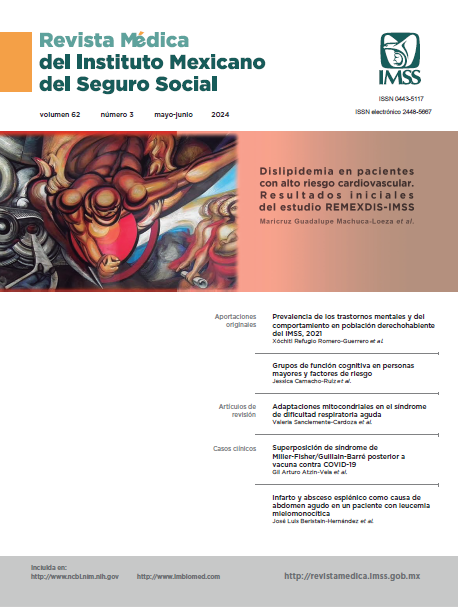Factors associated with physical dependency in adults with hip fracture
Main Article Content
Keywords
Functional Status, Hemiarthroplasty, Quality of Life, Hip Fractures
Abstract
Background: Hip fractures impact the quality of life and can lead to physical dependency, particularly in older adults.
Objective: To determine whether surgical treatment and other factors are associated with dependency in performing activities of daily living in elderly patients with hip fractures.
Material and methods: A cross-sectional analytical study was conducted at a regional general hospital from January 2019 to December 2021. Surgically treated patients with hip fractures were included. Follow-up was conducted for 6 months after surgery, and the Barthel Index and EQ-5D questionnaires were administered. Summary statistics and association measures were used for data analysis.
Results: A total of 126 patients with an average age of 78 ± 9 years were included. Patients with subcapital and basicervical fracture treated with hemiarthroplasty showed greater dependency compared to those treated with total hip arthroplasty with statistically significant differences. It was demonstrated that the greater the age the greater the dependency (p < 0.001), as well as prolonged hospital stay (p = 0.018). Cardiac disease was the comorbidity associated with increased dependency (p = 0.006).
Conclusion: The type of surgery emerged as a factor associated with dependency in patients with subcapital and basicervical fractures treated with hemiarthroplasty. The length of hospital stay and the presence of cardiac disease were also associated with physical dependency.
References
Izaguirre A, Delgado I, Mateo-Troncoso C, et al. A. Rehabilitación de las fracturas de cadera. Revisión sistemática. Acta Ortop Mex. 2018;32(1):28-35.
Mattisson L, Bojan A, Enocson A. Epidemiology, treatment and mortality of trochanteric subtrochanteric hip fractures: data from the Swedish fracture register. BMC Musculoskelet Disord. 2018;19(1):369.
Viveros-García JC, Torres-Gutiérrez JL, Alarcón-Alarcón T, et al. Fractura de cadera por fragilidad en México: ¿En dónde estamos hoy? ¿Hacia dónde queremos ir? Acta Ortopédica Mexicana. 2018;32(6):334-41.
Veronese N, Maggi S. Epidemiology and social costs of hip fracture. Injury. 2018;49(8):1458-60.
Kijima H, Yamada S, Kawano T, et al. Characteristics and Treatment Strategies for Basicervical and Transcervical Shear Fractures of the Femoral Neck. J Clin Med. 2023;12(22):7024. doi: 10.3390/jcm12227024.
Toro G, Pola E, Miranda R, et al. Extracapsular femoral neck fractures treated with total hip arthroplasty: identification of a population with better outcomes. Orthop Rev (Pavia). 2022;14(6):38576. doi: 10.52965/001c.38576.
Mercouris M, Klopper S, Swanepoel S, et al. Conservative Management of Stable, Minimally Displaced Pertrochanteric Fractures: A Case Series. J West Afr Coll Surg. 2023;13(1):91-5. doi: 10.4103/jwas.jwas_223_22.
Zilmer CK, Kristensen MT, Magnusson SP, et al. Intensified acute in-hospital physiotherapy for patients after hip fracture surgery: a pragmatic, randomized, controlled feasibility trial. Disabil Rehabil. 2023:1-10. doi: 10.1080/09638288.2023.2288672.
Gnanendran D, Yanaganasar Y, Rajan JM, et al. Clinical Effectiveness of Total Hip Arthroplasty Compared with Hemiarthroplasty in Adults Undergoing Surgery for Displaced Intracapsular Hip Fracture: A Single-Centre Retrospective Cohort Study. Cureus. 2023;15(9):e45807. doi: 10.7759/cureus.45807.
Geetala R, Wakefield E, Bradshaw F, et al. M. Comparison of intra-operative outcomes following internal fixation with trochanteric stabilisation plate or intramedullary nail in intertrochanteric fractures. Eur J Orthop Surg Traumatol. 2023. doi: 10.1007/s00590-023-03779-5.
Keppler AM, Holzschuh J, Pfeufer D, et al. Postoperative physical activity in orthogeriatric patients – new insights with continuous monitoring. Injury. 2020;51(3):628-32.
Regenbogen S, Leister I, Trulson A, et al. Early Stabilization Does Not Increase Complication Rates in Acetabular Fractures of the Elderly: A Retrospective Analysis from the German Pelvis Registry. J Clin Med. 2023;12(22):7043. doi: 10.3390/jcm12227043.
Welsh A, Hanson S, Pfeiffer K, et al; Hip Helper Study Collaborators. Perspectives of informal caregivers who support people following hip fracture surgery: a qualitative study embedded within the HIP HELPER feasibility trial. BMJ Open. 2023;13(11):e074095. doi: 10.1136/bmjopen-2023-074095.
McLaughlin MA, Orosz GM, Magaziner J, et al. Preoperative status and risk of complications in patients with hip fracture. J Gen Intern Med. 2006;21(3):219-25.
Sanz-Reig J, Salvador Marín J, Ferrández Martínez J, et al. Prognostic factors and predictive model for in-hospital mortality following hip fractures in the elderly. Chinese J Traumatol. 2018;21(3):163-9.
Forni C, Gazineo D, D'Alessandro F, et al. Predictive factors for thirty day mortality in geriatric patients with hip fractures: a prospective study. Int Orthop. 2019;43(2):275-81. doi: 10.1007/s00264-018-4057-x.
Jayasinghe G, Kumar R, Buckle C, et al. Patient mortality after total hip arthroplasty revision surgery. J Orthop. 2023;47:45-9. doi: 10.1016/j.jor.2023.11.020.
Zhao Y, Alderden J, Missbrenner N. Dementia and Postoperative Delirium in Surgical Hip Fracture Patients: Unveiling Contrasting Risk Factors and Implications. J Gerontol Nurs. 2023;49(12):25-30. doi: 10.3928/00989134-20231108-03.
Yang TI, Kuo YJ, Huang SW, et al. Minimal short-term decline in functional performance and quality of life predicts better long-term outcomes for both in older Taiwanese adults after hip fracture surgery: a prospective study. J Orthop Surg Res. 2023;18(1):791. doi: 10.1186/s13018-023-04278-3.
Chen L, Jiang JB, Ma H, et al. Factors associated with early failure of the femoral neck system (FNS) in patients with femoral neck fractures. BMC Musculoskelet Disord. 2023;24(1):912. doi: 10.1186/s12891-023-06994-7.
Tarazona-Santabalbina FJ, Ojeda-Thies C, Figueroa Rodríguez J, et al. Orthogeriatric Management: Improvements in Outcomes during Hospital Admission Due to Hip Fracture. Int J Environ Res Public Health. 2021;18(6):3049. doi: 10.3390/ijerph18063049.
Pech-Ciau BA, Lima-Martínez EA, Espinosa-Cruz GA, et al. Fractura de cadera en el adulto mayor: epidemiología y costos de la atención. Acta Ortop Mex. 2021;35(4):341-7.
Zhang X, Zhang A, Yang X. Clinical study on the effect of intramedullary fixation and extramedullary fixation on unstable intertrochanteric fractures. Ann Palliat Med. 2021;10(12):12857-66. doi: 10.21037/apm-21-3635.
Duymus TM, Aydogmus S, Ulusoy I, et al. Comparison of Intra- and Extramedullary Implants in Treatment of Unstable Intertrochanteric Fractures. J Clin Orthop Trauma. 2019;10(2):290-5. doi: 10.1016/j.jcot.2018.04.003.
Slobogean GP, Sprague S, Bzovsky S, et al. Fixation using Alternative Implants for the Treatment of Hip Fractures (FAITH-2): The Exploratory Health-Related Quality of Life and Patient-Reported Functional Outcomes of a Multi-Centre 2 × 2 Factorial Randomized Controlled Pilot Trial in Young Femoral Neck Fracture Patients. Injury. 2021;52(10):3051-9. doi: 10.1016/j.injury.2021.02.030.


